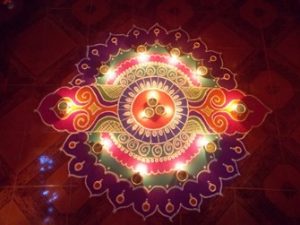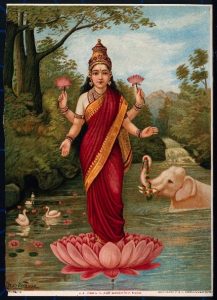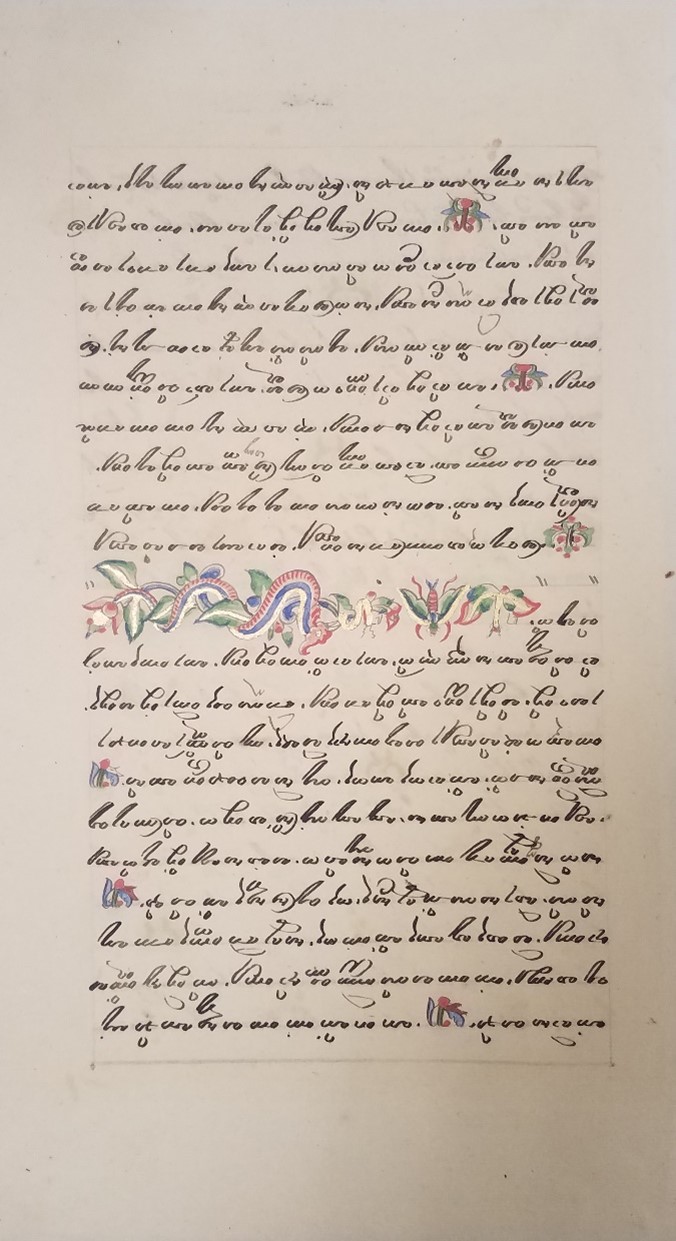Page from “The History of Rama”
19th century Javanese Manuscript
Ink on Dutch paper
Herbert Kraft Manuscript Collection, MSS 0029
ON THIS AUSPICIOUS FESTIVAL OF LIGHTS, MAY THE GLOW OF JOY, PROSPERITY AND HAPPINESS ILLUMINATE YOUR LIFE AND YOUR HOME.
This hand-written page comes from the Ramayana, one of the most notable ancient epics in world literature. This particular text has been translated from Kawi, an ancient script of the Indonesian island of Java. Kawi borrows considerably from Sanskrit, the classical language of South Asia.[1]

The Ramayana, from Hindi mythology, recounts how Lord Rama, following 14 years in exile, returned to find his wife Sita had been kidnapped by Ravana, the demon ruler of Lanka.[2] Sita’s kidnapping resulted in a war in which Rama was ultimately victorious over King Ravana and his forces. Rama and Sita then began their long journey home, their way lit by oil lamps set out by people to guide them on their way and welcome them back.[3] Rama was crowned king upon his return and large festivities were held to memorialize his triumph.

The story of Rama is the basis for Diwali celebrations, a festival observed by millions of Hindus, Sikhs and Jains across the world. It is often called the festival of lights, reflected in the bold displays of color and light symbolizing Rama’s victory of light over darkness and good’s triumph over evil.[4] Diwali is commemorated worldwide with fireworks, light displays, dancing and food. In addition to the larger festivities, people decorate their homes with lights and rangolis – an art form that consists of precise and elaborate geometric patterns that are made from a variety of materials including rice, colored sand and flowers.[5] The holiday is often associated with Lakshmi, the Goddess of prosperity, as this festival is also a time to bring prosperity into one’s life. Prayer, worship and rituals (puja) to Lakshmi are an important part of the celebrations and this deity is worshipped especially during this time.[6]

Copyrighted work available under Creative Commons Attribution only license CC BY 4.0
http://creativecommons.org/licenses/by/4.0/
Hindus, Sikhs and Jains across the United States observe Diwali, including many in New Jersey specifically. Though the Hindu population is considered a minority in America at less than 1% of the country’s total population, New Jersey has the largest concentration of Hindu people in the nation, making up 3% of the total state population. New Jersey is also home to the world’s largest Hindu Temple, the BAPS Shri Swaminarayan Mandir Temple located in Robbinsville. The temple is astonishingly large at 133 feet in length, 87 feet in width, and 42 feet in height – covering 162 acres.[7] Adherents of Jainism first arrived in the United States in the 20th century, with immigration beginning in earnest in the late 1960s and continuing to the present day. Siddhachalam, a mission located in Blairstown, New Jersey is the first pilgrimage site for Jains outside of India to gather in one place for worship, study and reflection. The mission is a religious public charity in special consultative status with the United Nations.[8] In the 1980s, Sikh immigrants from India began arriving in America, with many settling in New Jersey. New Jersey and New York have among the largest populations of Sikhs in the country. Gurbir Grewal, New Jersey’s attorney general, and Ravi Bhalla, the mayor of Hoboken, are some of the most well-known Sikhs in New Jersey politics.[9]

The Walsh Gallery has a considerable collection of fine art, artifacts and archeological specimens for use by faculty, students and researchers. For access to this or other objects in our collections, contact us at 973-275-2033 or walshgallery@shu.edu to make a research appointment.
[1] https://en.wikipedia.org/wiki/Sanskrit, accessed 11/10/2020.
[2] https://www.britannica.com/topic/Ravana, accessed 11/10/2020.
[3] https://www.activityvillage.co.uk/the-story-of-diwali#:~:text=Rama%20is%20the%20hero%20of,kidnapped%20Sita%20from%20her%20captor.&text=And%20here%20is%20the%20beautiful,rescued%20by%20Rama%20and%20Hanuman.&text=In%20the%20story%20of%20Diwali,Rama%20and%20Sita’s%20return%20home, accessed 11/20/2020.
[4] https://metro.co.uk/2019/10/27/diwali-say-someone-celebrating-festival-10990832/?ito=cbshare, accessed 11/6/2020.
[5] https://en.wikipedia.org/wiki/Rangoli, accessed 11/10/2020.
[6] https://www.hindustantimes.com/art-and-culture/diwali-2018-history-and-significance-of-deepawali-festival/story-S6lqJCmVDJwjgXEmZTW1TO.html, accessed 11/10/2020.
[7] https://www.worldatlas.com/articles/us-states-by-population-of-hindus.html#:~:text=Hinduism%20in%20New%20Jersey,Mandir%20Temple%20located%20in%20Robbinsville, accessed 11/10/2020.
[8] https://www.siddhachalam.org/about/, accessed 11/10/2020.
[9] https://www.nytimes.com/2018/08/14/nyregion/sikh-bigotry-power-nj.html, accessed 11/10/2020.
